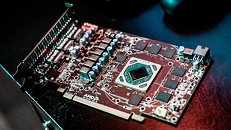Thursday, June 16th 2016

AMD "Ellesmere" ASIC Pictured Up Close in RX 480 PCB Picture Leak
AMD's all-important Polaris10 "Ellesmere" ASIC is pictured up close in a 3-quarter PCB shot of the upcoming Radeon RX 480 / RX 470. The picture reveals the ASIC with a die that's significantly smaller than that of the 28 nm "Tonga" silicon. The "Ellesmere" die is built on the 14 nm FinFET+ process. The die is seated on a substrate with a 256-bit wide GDDR5 memory interface. This appears to be a common reference PCB between the RX 480 and the RX 470.
The RX 480 ships with a classy looking lateral-flow cooler that's longer than the PCB itself; while the RX 470 uses a more common fin-stack top-flow cooling solution. Of course both cards are expected to ship with custom-design boards and cooling solutions. The reference PCB draws power from a single 6-pin PCIe power connector, and uses a 6-phase VRM to condition it for the GPU and memory. Display outputs include three DisplayPort 1.4 and one HDMI 2.0a connectors. There are also unused traces on the PCB for a DVI connector, so it's likely that some custom-design cards could feature it.
Source:
VideoCardz
The RX 480 ships with a classy looking lateral-flow cooler that's longer than the PCB itself; while the RX 470 uses a more common fin-stack top-flow cooling solution. Of course both cards are expected to ship with custom-design boards and cooling solutions. The reference PCB draws power from a single 6-pin PCIe power connector, and uses a 6-phase VRM to condition it for the GPU and memory. Display outputs include three DisplayPort 1.4 and one HDMI 2.0a connectors. There are also unused traces on the PCB for a DVI connector, so it's likely that some custom-design cards could feature it.

73 Comments on AMD "Ellesmere" ASIC Pictured Up Close in RX 480 PCB Picture Leak
2. I love that you bring up all those other items that I myself mentioned as alternative "top spots" effectively you are just agreeing with me there is more then top end performance to graphics cards which is what I said the original comment was about.
Sure if the article was "AMD announced code name "Polaris" to drive their new gpus" then we can speculate purely on how it does (With no info whatsoever, very useful speculation im sure) but again, we are way beyond that.
We know the name "480" which according to AMDs nomenclature is not their top segment card at all (which I already said in my last post).
We know the price point, 200 dollars.
So yes we are at a point to talk about how this will sell compared to Nvidias much more expensive higher segmented cards and if this is a smart move form AMD, and again, we have been doing so all over this website for days now.
RX 480: 1266 => 1400 is 10.5% OC
RX 480: 1266 => 1500 is 18.5% OC
for comparison:
1080: 1866 => 2050 is 9.8% OC
1080: 1866 => 2100 is 12.5% OC
To summarize: AMD's GPU is rumored to OC at least on par or much better than nVidias.
PS
Oh, and AMD to allow messing with voltage, unlike nVidia.
PPS
wccftech.com/amd-rx-480-1500mhz-overclocking-tool-voltage-control/
XFX spotted with 1288Mhz base clock.
Which is somewhat weird.
please don't punish this guy, I'm sure he honestly doesn't get it.
I find it hilarious, sorry.
sigh.
This is on par/better than my 290 - which runs every game i play on ultra at 1080p - but does so with half the damn wattage, in a physically small card. THAT. IS. AWESOME.
1. Go back and look at the post i was replying to, that post was talking about how amd has similar or even better oc headroom that nvidia, which is true because amd is clocking this thing very conservatively at stock, so i simply said this round nvidia got mad clocks and i wonder if it has anything to do with 14nm vs 16nm. Does that make more sence now? How about you guys contribute to a logical argument rather than being all offended. And secondly, any sane person will not compare gpu to cpu, in cpu single threaded performance is important so clock as well as ipc go hand in hand, then after than comes number of cores, gpus on the other hand arent that way since its all about fitting as many cores and clocking them as high as you possibly can before reaching thermal headroom. So while clock is not everything, it still works differently than with cpus
So instead of arguing with the entire forum, all of whom has said you are wrong how about do some research.
Oh and just in case you missed it clockspeed doesn't matter. The GTX980 hit 2.3ghz in 2015, it also wasn't the first GPU to do so. www.kitguru.net/components/graphic-cards/anton-shilov/evga-geforce-gtx-980-hits-2-30ghz-sets-new-records/